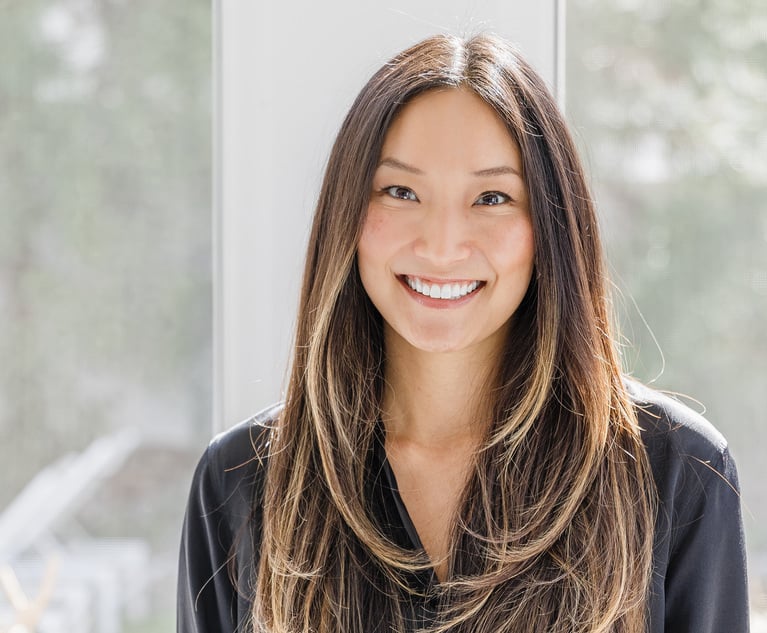26 In-House Leaders Join Five Law Firms in $5M Move the Needle Fund With Diversity Lab
Yes, this is another diversity initiative. But resist the urge to eye roll—this is shaping up to be a different animal: an initiative built on collaboration, transparency and accountability wrapped around a framework of measurable, public diversity goals.
September 20, 2019 at 12:40 PM
7 minute read
 Photo: Flamingo Images/Shutterstock
Photo: Flamingo Images/Shutterstock
Diversity initiative announcements are nearing the point of eye-rolling ubiquity. Companies and law firms have been talking for years about hiring and promoting minorities and women. Yet the majority of executives, legal department leaders and law firm partners are still white males.
"The tried-and-true conventional approaches that the legal industry has been following are not working at the rate of progress that we'd like to see," said Allon Stabinsky, senior vice president and chief deputy general counsel of Intel Corp.
Bradley Gayton, Ford Motor Co.'s chief administrative officer and general counsel, acknowledged that "there is a fair amount of fatigue in this space."
He added, "One of the things I've stopped doing is talking about why diversity is important. We're really focused more on what we can do to change things."
Gayton and Stabinsky are among a group of 26 in-house leaders from a broad cross-section of major brands, including Pfizer Inc., Uber Technologies Inc., PayPal, Starbucks Corp. and the San Francisco 49ers, that have joined with several law firms and Diversity Lab to create a multimillion-dollar think tank to address the legal industry's diversity problem.
Yes, this is another diversity initiative. But resist the urge to eye roll—this is shaping up to be a different animal: an initiative built on collaboration, transparency and accountability wrapped around a framework of measurable, public diversity goals.
Competitors unite, invest $5 million
To get things moving, the participating law firms—Orrick, Herrington & Sutcliffe; Goodwin Procter; Eversheds Sutherland; Stoel Rives; and a fifth that will be named later through a blind selection process—are investing $5 million in a "Move the Needle Fund."
"These are law firms that compete for business. These are not natural collaborators," said one of the initiative's founding in-house leaders, Lora Blum, senior vice president, general counsel and secretary of SurveyMonkey Inc. "A unique aspect of this is getting commitments from firms that normally would not work together."
Blum and Stabinsky said their companies have worked with a few of the firms involved in the initiative, but the firms have not served as their go-to outside counsel. Stabinsky noted he was initially reluctant to "spend a lot of resources on helping law firms that are not significant legal providers to me."
But then it occurred to him that he could experiment and work with the five firms at Diversity Lab and take what he learns back to Intel's primary outside counsel.
"To me, that's an additive thing," he said. "Two is better than one."
Over the next five years, the law firms will work with Diversity Lab to establish "aggressive, measurable diversity goals" and "experiment with research-based and data-driven ways to achieve" those goals, according to an announcement.
At the same time, the companies and their in-house leaders will use their legal departments as testing grounds for the ideas that emerge from Diversity Lab. They hope to bring 100 more legal departments into the fold by 2020.
Both sides have vowed to publicly report their findings and progress as the effort unfolds. Transparency, which has been lacking in too many previous initiatives, is a key element of the effort.
"One of the things that people are nervous about, whether it be companywide or within legal departments or law firms, is people will put out their numbers but they won't necessarily put out their goals," Blum said. "Even if you don't meet your diversity goals, if you are brave enough to put them out there and share what you might do to meet them later—that can be an incredibly powerful statement."
'More work needs to be done'
Blum, Stabinsky and the other two dozen in-house leaders asserted in an open letter that they joined "Move the Needle" because they realized it was taking too long to bring transformative change to the legal industry.
According to Diversity Lab, predictive modeling based on the last five years of ALM data suggests that, at the current rate of progress, it will take another 37 years for the percentage of women in equity partnerships at the largest 200 law firms in the country to reflect the number of women law school graduates, which has hovered around 50%. For racial minorities, it will take 64 years.
"Where we've all failed in the legal profession is figuring out how to keep women and a more diverse population moving up through the ranks," Blum said.
Intel has spent about $300 million in-house and externally since 2015 on diversity initiatives, according to Stabinsky. As part of the effort, the tech giant offers bonuses for outside firms that make progress with their diversity metrics.
But Stabinsky said the "data is really spiky, and I'm not seeing a trend line that's making me feel like we're on a positive trajectory. More work needs to be done."
Is $5 million enough?
In light of the $300 million that Intel has spent on diversity, Stabinsky was asked whether $5 million was sufficient to spur real change.
"We talked about this a lot within the Move the Needle Fund. I'll be candid, when you look at the things in the press release, if you look at it at a macro level you can say, '$5 million is not going to be enough to drive transformative change throughout an entire industry,'" he said. "But if you look at it at the micro level, think of this as an incubation laboratory. Investing $5 million in your laboratory is a huge investment."
The ideal outcome, in Stabinsky's view, is that the ideas that come out of the lab will go viral, spreading across legal departments and law firms of all sizes and in all industries. If enough corporations buy into the initiative and implement diversity programs from the lab, outside law firms that want their business will want to get on board.
"We're going to give exposure to these new law firms. But we're not going to give exposure to the usual suspects," he said of the firms in the initiative. "If we can establish relationships and books of business with diverse lawyers, they will assume leadership positions in the firm and they will attract more diverse talent who will say, 'I can succeed in a law firm like this.'"
He added, "It's about influencing the composition of the next generation of diverse lawyers."
And it's OK to remain skeptical. Blum acknowledged she and her fellow in-house leaders approached the initiative with a "healthy amount of skepticism." When someone in the group had an idea, she said the others wanted to know what made it different or novel, what sets it apart from other initiatives, other failed efforts.
"I think the only way that we will be different is if we follow through, which we intend to," she said.
This content has been archived. It is available through our partners, LexisNexis® and Bloomberg Law.
To view this content, please continue to their sites.
Not a Lexis Subscriber?
Subscribe Now
Not a Bloomberg Law Subscriber?
Subscribe Now
NOT FOR REPRINT
© 2025 ALM Global, LLC, All Rights Reserved. Request academic re-use from www.copyright.com. All other uses, submit a request to [email protected]. For more information visit Asset & Logo Licensing.
You Might Like
View All
Trump Taps McKinsey CLO Pierre Gentin for Commerce Department GC

Upstart Insurer That's Wowing Industry Hires AIG Legal Exec to Help Guide Global Expansion
2 minute read
GOP-Led SEC Tightens Control Over Enforcement Investigations, Lawyers Say

Trending Stories
Who Got The Work
J. Brugh Lower of Gibbons has entered an appearance for industrial equipment supplier Devco Corporation in a pending trademark infringement lawsuit. The suit, accusing the defendant of selling knock-off Graco products, was filed Dec. 18 in New Jersey District Court by Rivkin Radler on behalf of Graco Inc. and Graco Minnesota. The case, assigned to U.S. District Judge Zahid N. Quraishi, is 3:24-cv-11294, Graco Inc. et al v. Devco Corporation.
Who Got The Work
Rebecca Maller-Stein and Kent A. Yalowitz of Arnold & Porter Kaye Scholer have entered their appearances for Hanaco Venture Capital and its executives, Lior Prosor and David Frankel, in a pending securities lawsuit. The action, filed on Dec. 24 in New York Southern District Court by Zell, Aron & Co. on behalf of Goldeneye Advisors, accuses the defendants of negligently and fraudulently managing the plaintiff's $1 million investment. The case, assigned to U.S. District Judge Vernon S. Broderick, is 1:24-cv-09918, Goldeneye Advisors, LLC v. Hanaco Venture Capital, Ltd. et al.
Who Got The Work
Attorneys from A&O Shearman has stepped in as defense counsel for Toronto-Dominion Bank and other defendants in a pending securities class action. The suit, filed Dec. 11 in New York Southern District Court by Bleichmar Fonti & Auld, accuses the defendants of concealing the bank's 'pervasive' deficiencies in regards to its compliance with the Bank Secrecy Act and the quality of its anti-money laundering controls. The case, assigned to U.S. District Judge Arun Subramanian, is 1:24-cv-09445, Gonzalez v. The Toronto-Dominion Bank et al.
Who Got The Work
Crown Castle International, a Pennsylvania company providing shared communications infrastructure, has turned to Luke D. Wolf of Gordon Rees Scully Mansukhani to fend off a pending breach-of-contract lawsuit. The court action, filed Nov. 25 in Michigan Eastern District Court by Hooper Hathaway PC on behalf of The Town Residences LLC, accuses Crown Castle of failing to transfer approximately $30,000 in utility payments from T-Mobile in breach of a roof-top lease and assignment agreement. The case, assigned to U.S. District Judge Susan K. Declercq, is 2:24-cv-13131, The Town Residences LLC v. T-Mobile US, Inc. et al.
Who Got The Work
Wilfred P. Coronato and Daniel M. Schwartz of McCarter & English have stepped in as defense counsel to Electrolux Home Products Inc. in a pending product liability lawsuit. The court action, filed Nov. 26 in New York Eastern District Court by Poulos Lopiccolo PC and Nagel Rice LLP on behalf of David Stern, alleges that the defendant's refrigerators’ drawers and shelving repeatedly break and fall apart within months after purchase. The case, assigned to U.S. District Judge Joan M. Azrack, is 2:24-cv-08204, Stern v. Electrolux Home Products, Inc.
Featured Firms
Law Offices of Gary Martin Hays & Associates, P.C.
(470) 294-1674
Law Offices of Mark E. Salomone
(857) 444-6468
Smith & Hassler
(713) 739-1250






